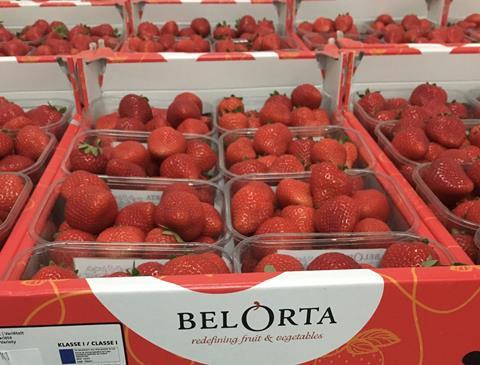Strawberry volumes from Belgium are set to rise in the coming weeks as the new campaign hits its stride, but the main issue going forward is diminishing returns for growers
Belgian cooperative BelOrta is prepared for the new strawberry campaign in Belgium, with the first volumes of the season already on the shelves and peak volumes arriving in the next month.

“Last year, the season started late, but we are on schedule this year,” said Miguel Demaeght, sales manager for fruit at BelOrta. “The first growers with heated greenhouses and extra lighting started on around 7 March, but the big volumes will start around week 14.”
According to Demaeght, the giant peaks and troughs of previous years may be a thing of the past, as various factors combine to flatten out volumes.
“The peak months used to be April, May and June, but our growers, through new systems of growing and their choice of varieties, now experience a longer season without the huge peaks,” said Demaeght. “Our growers have shifted from June-bearing strawberries to ever-bearing varieties. So we have also good volumes in July, August and September.”
BelOrta is also seeing a continued shift from in-soil production to substrate. “This is due to the availability of land, as well as the practicality of getting people and packaging materials to the fields,” said Demaeght. “Growers now use high-tech table-top systems that require no soil. Fifteen years ago, around two-thirds of our growers produced in the soil; now 80 per cent use substrate. This trend has been gradual. It is partly due to the cost of labour, which is expensive in the strawberry category and accounts for 45-50 per cent of overall costs. You can also get a higher tonnage per hour from the table-top system, as it’s the perfect height for picking.”
When it comes to varieties, Elsanta leads among BelOrta’s growers with 27 per cent, followed by Sensation (20 per cent), Karima and Malling (10 per cent each), Elegance and Lady Emma (9 per cent each), Verity (5 per cent) and Parlando (3 per cent).
“We have 115 growers in both Flanders and the Netherlands, producing around 12,000 tonnes a year,” said Demaeght. “For us, our home market, selling under the BelOrta name, is hugely important. 40 per cent of our strawberries stay in Belgium, with 60 per cent exported to markets including the Netherlands, Germany, the UK, France and Scandinavia.”
A huge challenge for strawberry growers in Belgium remains high costs, but supermarkets all across Europe fear the consequences of raising prices on consumers who are already suffering the effects of inflation.
“Costs have increased for everything – substrates, plant material, fertiliser, energy, phytosanitary products, labour,” said Demaeght. “It’s hard to shift these extra costs on to the final customer. Strawberries have become a commodity over the decades, but maybe that is changing.”
The alternative to higher prices, he said, is fewer strawberries. “If the strawberries are too expensive, we will lose consumers,” he concluded. “If they are too cheap, we will lose the growers themselves.”



